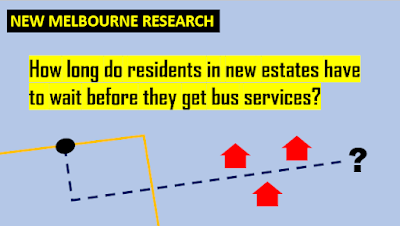Nothing much by me today but I can bring you something both better and more important.
It's RMIT research on how long it takes for new estates in Melbourne to get bus routes put in.
This is absolutely vital. Because people are most likely to change their transport habits when they face a major change in their life circumstances. That can include a new work location, large changes in income or (especially) moving house.
This is because peoples' habits are shaped by the transport they find (or don't find) in their new location. If cycling is easier and parking is harder then that will change how they get around. And in the long term households (especially couples) will sell their second (and sometimes even only) car. Thus further decreasing car usage.
Conversely if people move to an area with no public transport then high car use will be entrenched as part of daily life from Day One. Couples getting by with one car will buy another even if they'd rather use the money for another purpose (including affording the basics for those on low incomes) since having one car per adult is pretty much a pre-requisite to finding or keeping work. Or even a basic level of community participation.
Public transport connections established well after most people move in will still get used but since people have bought all their cars usage won't be as high compared to if it was established early in a suburb's establishment when it had a chance shape peoples travel habits from the start.
Thus having even a basic bus service early in a new suburb's life is essential to give it the best chance of success. And to allow residents the choice of buying only the cars they want to have, not those that poor transport forces them to have. Getting more people on public transport right from their neighbourhood has wider benefits, especially if both road connections and parking at the nearest station are limited.
I've written multiple times about new suburbs waiting for public transport well after people have moved in. How typical is this experience in outer Melbourne?
You're about to find out thanks to this great new paper by researchers Annette Kroen, Steve Pemberton & Chris De Gruyter. In a nutshell 3 to 4 years it typical, though waits can be up to 14 years. And, while it's beyond the research's scope, I'd argue that 30 to 40 year established areas like Rowville, Lysterfield, Ringwood East, Croydon, Frankston South and many more remain lacking without a full service too, getting, at best unreliable or limited hours FlexiRide services.
The above doesn't do the research justice. So I think you should read the paper here.
https://www.sciencedirect.com/science/article/pii/S1077291X23000292
It's also worth nothing that even where there is service the limitations of leap-frog development, the lack of through roads and/or highly conditional GAIC funding can lead to a pattern of multiple overlapping and infrequent routes
such as in Clyde North where not a single bus runs continuously from Berwick to Cranbourne, despite both being destinations where people would wish to go. Long-term government uninterest in bus network reform and slow internal processes (when there is interest) can mean that even though suitable through roads get built and level crossings removed, it can take years (sometimes decades) for buses to get routes that take advantage of these works.
In contrast things were done differently (and better) a century ago. For example
here is a case (from a century ago) where the bus was put in before all the blocks were developed.

No comments:
Post a Comment